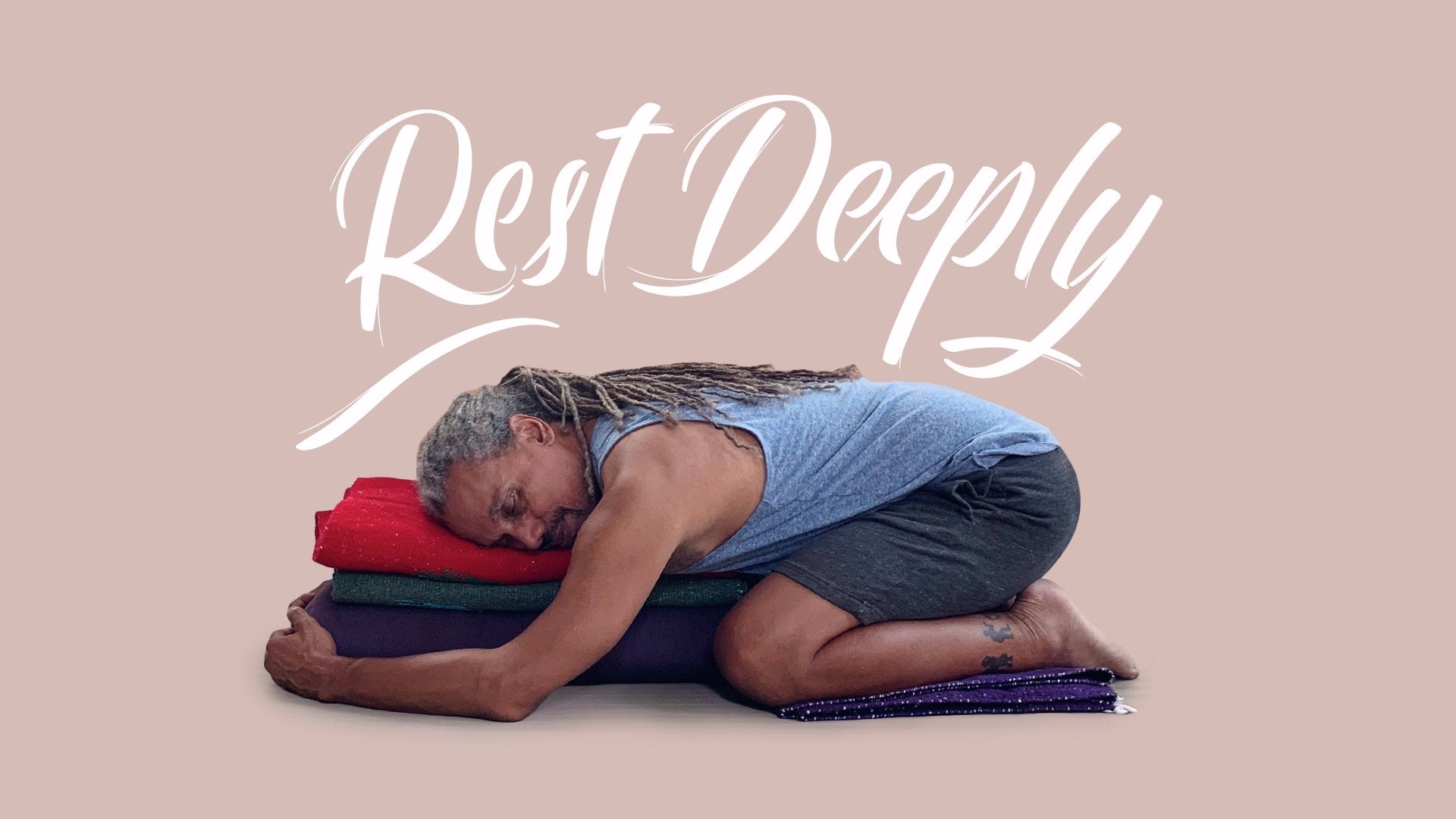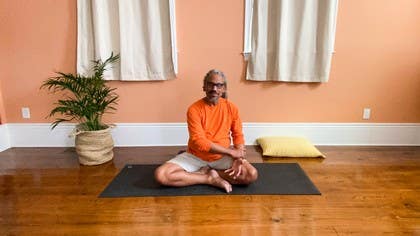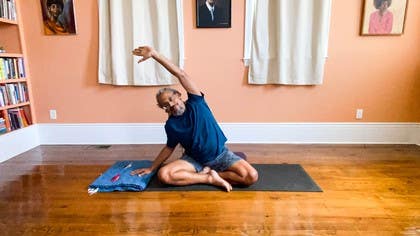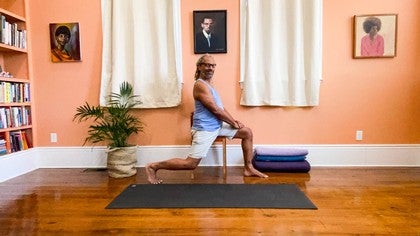Description
About This Video
Transcript
Read Full Transcript
Hi and welcome to the practice. Today we're going to work and explore the connection between the heart and pericardium meridians. Pericardium in Chinese medicine is the heart protector, the case around the heart. And those meridians come very much to the surface out towards the edges of the hands and then dive in deep to the body, into the organs, into the physical organs. So we're going to start out here at the edges. Sitting comfortably, try to get your knees a little lower than your hips. And I'm going to take my left hand, take a hold of the fingers, straighten through the elbow, and then draw the fingers back towards my legs so that I get to stretch this palm side of the forearm. I can even lean into it a little bit. You may bring this down to your foot or down to your knee. And what I'd like you to do is to explore a couple of different positions. Try coming a little further forward. And breathing. Try coming across towards the opposite knee or floor and still breathing. Maybe even just across towards the opposite shoulder. You're the one inside there so you can explore and find the angles that feel good. And then slowly release. Let's do the other side. Palm forward, take a hold of the fingertips, straighten the elbow, and draw the fingertips back to stretch across the palm and up into these forearm muscles. These forearm muscles, as well as being the pathways for the heart and pericardium meridians, these are also areas where if you're doing anything like this, typing. I'm going to explore a few different positions. If you're gripping your hands on a steering wheel, these forearm muscles get overworked and are really understretched and underloved. And because the heart and pericardium meridians are really superficial out in the fingers and wrists, we can bring our intention into opening the heart through these connections with our breath, with our intention. And slowly release. Coming back to the first hand, I'm going to come to the pinky and come to the very edge of the nail bed and kind of smoosh around. Not too hard because these points can be tender, but I'm just going to draw some little circles and smoosh and then take, when I find a little tender point, I'm going to hold it and play with some movement. Oh, so now I can feel when I draw on the pinky, I can feel it connecting all the way into my armpit. And then coming to the heart protector, the pericardium, which is this finger. I'm not going to show it by itself. I'm going to smoosh around. And again, find a spot while I'm holding that point at the end of the finger. And release. Coming over to the other side, and you might find two tender points on the outside and inside of the pinky, a little bonus. And then again, play with the movement. Feel your breath move. Oh, I got a good one. And you may feel this connecting all the way in through the armpit. And right here in the armpit is where the heart and pericardium meridians go deep into the body and connect into the organs themselves. And coming on down. I'm going to take my right palm to my forearm and really I'm going to grip it and then ring it almost like I'm ringing out a washcloth. Going to ring from my wrist up towards my elbow. And then ring the opposite direction back down towards the wrist and your fingers as you're ringing, you may feel your fingers automatically. Oh, the hand automatically closing and go again, ringing towards the elbow and then back down towards the wrist. And then come to the base of the pinky side of the hand, drop just to the wrist crease and draw some little circles right there until you find a little tender point. You find that tender point, open the palm gently, breathe in through the palm towards your heart and out from your heart towards your palm.
And then switching hands, gonna ring the other forearm from the wrist up towards the elbow and from the elbow down towards the wrist and going back up again. Go just at the right amount of pressure where it feels good, but not so much pressure that you might bruise yourself. And keep breathing. Next time you come down to your wrist, stop ringing, come to the base of the pinky side of the hand, just at the wrist crease and smoosh in there and see if you can find a little tender point. This is one of the, there's four points in a row right here for the heart and this is one of the more important points for the heart organ itself. Gently spread the palm open and breathe into the heart and breathe out from the heart towards the palm. And then release. And I'm gonna turn a little sideways so you can see we're gonna smoosh on one point, another point. And come right here to the shoulder blade. And the way to find the point is so I'm reaching underneath and I'm gonna draw some circles, press in and draw some circles and everybody has a tender point right there. It's on a rotator cuff muscle. It's on the infraspinatus. I'm gonna smoosh that, hold it and then move my arm a little bit until I feel it stretch underneath. This is on the small intestine meridian, which is the heart's paired organ. It's the young meridian that's associated with the heart. Now, if you have a friend that can do this for you, it's even better with somebody else doing this. But if you're solo, you can do this on yourself. And this is really nice for opening the whole shoulder and opening the backside of the heart, which is part of the heart that tends to get really armored. A lot of us hold armoring along the back sides of our heart. And release. I'm gonna switch to the other side. You all don't need to switch side to side. I'm just doing this so you can see. Find the center of the shoulder blade, draw some circles. Oh, I found it. Find that tender point and then play with the little movement, maybe rotating the whole arm. Another way you can do this on your own is if you have a tennis ball around, you can lay on the tennis ball on the shoulder blade gently and do the same thing on your back. And breathing into the back of the heart here. And release. Take a moment sitting up. Shoulders relaxed. And then we're going to come onto our back. So taking your cushion at one end and taking a head pillow at the other end and come to lay on your spine and bring your feet up onto the cushion. We're going to do a little bit of massage in between the shoulder blades, but we're going to do it with movement. And actually, I'm going to slide this out for a moment because I'm going to lift my hips a little bit. Inhale. As you exhale, engage the six pack and press down with your feet, lifting the hips up into a really gentle, gentle bridge. And then slowly roll your way down, one vertebrae at a time. Inhale. Exhale. Lift the hips. Roll back down. Take a little pause with the hips lifted. Inhale. Engage the abs as you exhale. Press down with feet. Lift the hips. This time we're going to keep the hips lifted and take advantage of the floor here, the pressure into the middle of the back, right behind the heart. You can keep your palms down or you can try reaching your hands towards the ceiling. And that will take the shoulder blades away from the center of the spine and let the floor get in and smoosh into the back of the heart. You may even want to roll a little to one side so you get into the side between the shoulder blade and the spine. And come over to the other side, all between the shoulder blade and the spine. Come back to the center. Bring your palms down. Inhale. And as you exhale, rolling down one vertebrae at a time. Take a pause here. Breathe into that space at the back of the heart. Breathe into your palms and fingers, especially the pinky finger side and the middle finger side of the palms. And then we're going to bring just a little bit of rocking into the whole spine. In the way to rock the whole spine, I want to imagine my tailbone sweeping side to side like I'm a very happy dog. But I'm going to just let that happen a little more rapidly. So all of the movement is coming from my hips and I'm just letting my torso, my spine, my head relax. If you see a very happy dog, you'll see all of their joy emanating from their tail, but that moves through their whole being like a wave rocking their bodies side to side. Relax your jaw as you do this. And gradually let the happy wag settle down to nothing, settle down to stillness. I'm going to reach up and bring my head pillow underneath my head and neck. Extend my legs out over the bolster, the cushion. Make any little shifty adjustments and you need to find complete ease and comfort. And take a few more breaths through the palms, into the heart, out from the heart, into the hands and palms. Letting your hands get heavy, your head relaxed and heavy. In the back of the heart, resting into the floor, in the front of the heart, soft, supple and fluid. If you want to stay in your final relaxation, you're welcome to stay here as long as you like. If you want to come up, you can start to breathe a little movement out into your toes and fingers. If you're coming up, you can bend one knee at a time and then slowly roll your way onto one side. Just pause on your side for a breath. From your side, let your head stay heavy.
Roll a little more forward and press your hands down. Let your head hang heavy. Slowly rolling up, one vertebrae at a time. Coming up to find a comfortable seated position. You may want to sit on your cushion. If you're staying in the relaxation, just rest. Then bringing the palms together, connecting the two sides of the heart and pericardium meridians. Feel that connection from the palms, from the fingers, up the arms, into the center of the body.
Rest Deeply
Comments
You need to be a subscriber to post a comment.
Please Log In or Create an Account to start your free trial.












